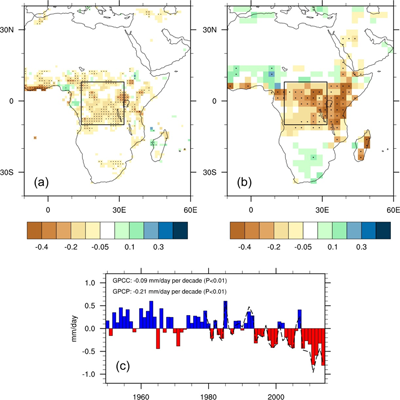Solving the Puzzle: Drought in Central Africa
ALBANY, N.Y. (December 14, 2016) – Central Equatorial Africa (CEA) has experienced a long-term drying trend over the past two decades. This trend may have reduced forest greenness and water content over the Congolese rainforest, the second largest rainforest in the world. Now, a team of researchers led by UAlbany atmospheric scientist Liming Zhou may have found out the possible cause.
The long-term drought during April, May and June over CEA may reflect the large-scale response of the atmosphere to tropical sea surface temperature (SST) variations. Likely the drought results primarily from SST variations over Indo-Pacific associated with the enhanced and westward-extended tropical Walker circulation (the large-scale atmospheric east-west equatorial circulation). These changes tend to induce subsidence and decrease convection over the Congo Basin, which lead to the reduction in low-level moisture transport and rainfall across the area. What remains to be determined is if these changes are the result of natural variability or global warming due to human activities.
 |
|
Patterns of rainfall change over Central Equatorial Africa.
|
Appearing in Environmental Research Letters, Zhou’s team states that these results reinforce the notion that tropical SSTs have large impacts on rainfall over equatorial Africa. The authors argue that more work needs to be done to further distinguish the contribution of SSTs changes (such as a La Niña-like pattern and Indian Ocean warming) due to natural variability, or ‘anthropological forcing’ such as greenhouse gases or aerosol pollution.
"The Congo rainforest has experienced a long-term drying trend since the 1990s while similar droughts are absent in other tropical rainforests," said Zhou, an associate professor in the Department of Atmospheric and Environmental Sciences. "Tropical rainforests have the potential to modulate regional and global climate via various feedbacks. Hence, understanding the nature and cause of this drought and assessing its impacts on the forests are of significant societal, economic and environmental importance."
Home to as many as 10,000 species of tropical plants, including 30 percent that are unique to the region, the Congo basin is teeming with life. Endangered species such as forest elephants, chimpanzees, bonobos, and lowland and mountain gorillas inhabit the lush forests. According to the World Wildlife Fund, about 400 other species of mammals, 1,000 species of birds and 700 species of fish can also be found in the Congolese rainforest.
Oceanic conditions, especially SSTs, have been highlighted as the driver for rainfall variations over Africa and other regions. SSTs modulate the rainfall variability not only via their direct and indirect impacts on atmospheric circulation, but also via their effects on moisture transport.
Over the long term, the drying trend is likely associated with rapid warming in the Indian Ocean and western Pacific Warm Pool. Tropical SSTs in other regions also have experienced obvious changes since 1979, with significant warming from the Atlantic to the western Pacific, and cooling in the central and eastern Pacific. These changes contribute to regional climate change through atmospheric 'teleconnections' (anomalies related to each other at large distances, typically thousands of kilometers). Even from halfway around the world, the Pacific Ocean has an indirect influence on African rainfall, as well as over the continent. But it remains to be seen if these changes are the result of human activity or internal variability.
"The changes in Pacific SSTs are likely due to natural multi-decadal variability. In contrast, the tropical Indian Ocean SST warming may result from global warming due mostly to human activities," said Dr. Wenjian Hua, lead author of the study and a postdoctoral fellow under the supervising of Prof. Zhou at Albany. "Whether the recent La Niña-like SST pattern is externally forced or internal variability is still unclear."
The study is funded by the National Science Foundation. Other contributors to this research include Haishan Chen at Nanjing University of Information Science & Technology in China, Sharon E. Nicholson at Florida State University, and two UAlbany graduate students Ajay Raghavendra and Yan Jiang.
![]() For more news, subscribe to UAlbany's RSS headline feeds
For more news, subscribe to UAlbany's RSS headline feeds
A comprehensive public research university, the University at Albany-SUNY offers more than 120 undergraduate majors and minors and 125 master's, doctoral and graduate certificate programs. UAlbany is a leader among all New York State colleges and universities in such diverse fields as atmospheric and environmental sciences, business, education, public health,health sciences, criminal justice, emergency preparedness, engineering and applied sciences, informatics, public administration, social welfare and sociology, taught by an extensive roster of faculty experts. It also offers expanded academic and research opportunities for students through an affiliation with Albany Law School. With a curriculum enhanced by 600 study-abroad opportunities, UAlbany launches great careers.


